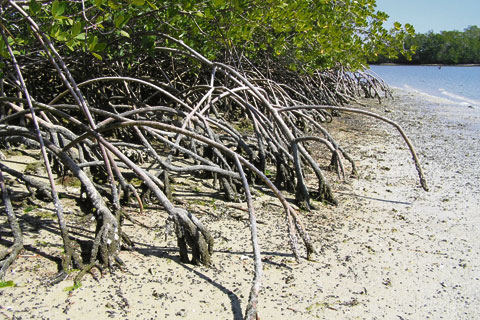Tomohiro Suzuki mimicked waves hitting salt marshes and mangrove forests to better understand the hydrodynamic forces at play.
The port situated near the mouth of India’s Dhamra River was recently completed, yet it is already under threat. Lying just in front of the port is a mangrove island that dissipates the waves, thereby protecting a harbor that lacks artificial wave breakers. Tomohiro Suzuki (Civil Engineering & Geosciences faculty) however warns that the island might not be there forever.
“The mangrove trees are susceptible to environmental changes,” he says. “Human activities such as dredging and increasing extreme events caused by climate change might alter the current situation.”
The Dhamra Port is one of the case studies described in Suzuki’s thesis, ‘Wave dissipation over vegetation fields’, which the hydraulic engineer will defend on 30 May. Suzuki ameliorated a computer program called Swan (Simulating Waves Nearshore), which was developed earlier at TU Delft, and used it simulate the situation at the Dhamra Port.
According to Suzuki, it is not well understood what happens when waves dissipate over vegetation fields, which renders it difficult to precisely predict how well these natural barriers protect coastal areas and how vulnerable the vegetation is. Until now, most research was conducted using relatively simple, one-dimensional models, he says.
To add more realism and complexity to the model, Suzuki conducted experiments in a water tank in Delft, mimicking vegetation fields with thousands of rigid wooden cylinders. The movements of little plastic balls, which he added to the water, gave him an exact picture of all the velocity fields.
Finding the right little balls was quite a feat. “The experiments would have been very expensive if I had asked a chemical company to produce them for me. So instead I used bullets from an air gun – a child’s toy. The density of these bullets was slightly too high so I plunged them in candle grease,” the researcher explains, laughing.
Suzuki discovered strong vortexes situated right in front of the vegetation – at the cliff – and behind the vegetation. “These vortexes might sweep away seedlings,” he says. “In view of conservation efforts, this is an interesting insight.”
Eind april werden de onderhandelingen al opgeschort. Het was toen ‘niet opportuun’ om over salarisverhoging te spreken, vond de VSNU. De werkgevers wilden de voorjaarsnota afwachten voordat er afspraken zouden worden gemaakt.
Uit de voorjaarsnota bleek dat de universiteiten geen geld zouden krijgen om de salarissen van werknemers te laten stijgen en gestegen prijzen te compenseren. Het Rijk wil de lonen bevriezen om de financiële tegenspoed het hoofd te bieden.
Dus bepleit de werkgeversvereniging nog steeds de nullijn, in de hoop de werkgelegenheid op peil te houden. “Een procent loonsverhoging is vierhonderd à vijfhonderd banen”, zegt onderhandelaar Hugo Levie van de VSNU. “Onze ruimte is beperkt.”
De bonden houden echter vast aan een salarisverhoging van 1,25 procent om de koopkracht veilig te stellen. “Universiteiten hebben een enorme begroting. Daar kunnen ze keuzes in maken”, zegt onderhandelaar Marieke van den Berg van Abvakabo FNV. “Bij gemeenten, provincies en waterschappen hebben de werknemers ook loonsverhoging gekregen. Je kunt investeren in gebouwen en machines, maar ook in personeel.”
Het gaat in de onderhandelingen ook om werkzekerheid, zegt ze: “Dat mensen de garantie krijgen dat ze aan de universiteit kunnen blijven werken en dat er niet allerlei reorganisaties volgen. Daar hebben we niets op gehoord. Universiteiten moeten goede, concurrerende werkgevers blijven.”
In het hbo is vanmorgen een principeakkoord gesloten, waarin de werknemers er volgend jaar 0,4 procent op vooruitgaan. Ook krijgen ze een eenmalige bonus van 460 euro.



Comments are closed.